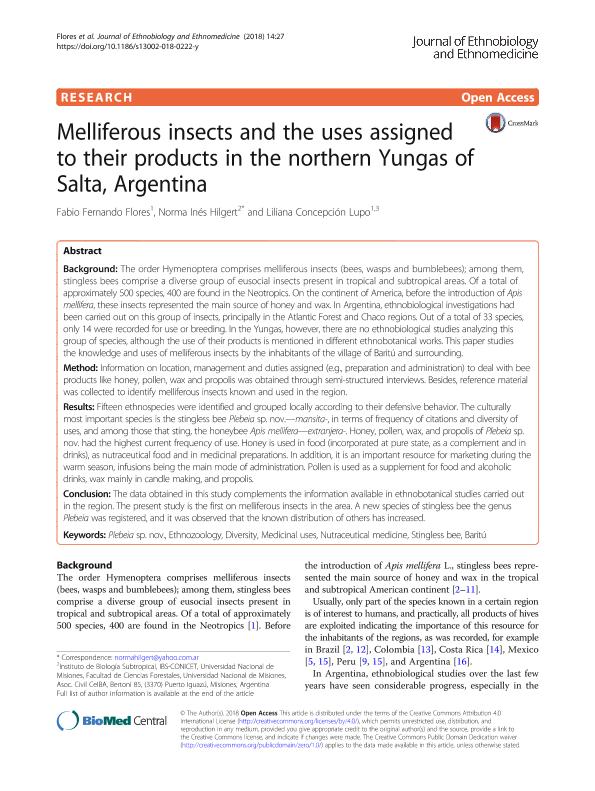Artículo
Melliferous insects and the uses assigned to their products in the northern Yungas of Salta, Argentina
Fecha de publicación:
04/2018
Editorial:
BioMed Central
Revista:
Journal of Ethnobiology and Ethnomedicine
ISSN:
1746-4269
Idioma:
Inglés
Tipo de recurso:
Artículo publicado
Clasificación temática:
Resumen
Background: The order Hymenoptera comprises melliferous insects (bees, wasps and bumblebees); among them, stingless bees comprise a diverse group of eusocial insects present in tropical and subtropical areas. Of a total of approximately 500 species, 400 are found in the Neotropics. On the continent of America, before the introduction of Apis mellifera, these insects represented the main source of honey and wax. In Argentina, ethnobiological investigations had been carried out on this group of insects, principally in the Atlantic Forest and Chaco regions. Out of a total of 33 species, only 14 were recorded for use or breeding. In the Yungas, however, there are no ethnobiological studies analyzing this group of species, although the use of their products is mentioned in different ethnobotanical works. This paper studies the knowledge and uses of melliferous insects by the inhabitants of the village of Baritú and surrounding. Method: Information on location, management and duties assigned (e.g., preparation and administration) to deal with bee products like honey, pollen, wax and propolis was obtained through semi-structured interviews. Besides, reference material was collected to identify melliferous insects known and used in the region. Results: Fifteen ethnospecies were identified and grouped locally according to their defensive behavior. The culturally most important species is the stingless bee Plebeia sp. nov.-mansita-, in terms of frequency of citations and diversity of uses, and among those that sting, the honeybee Apis mellifera-extranjera-. Honey, pollen, wax, and propolis of Plebeia sp. nov. had the highest current frequency of use. Honey is used in food (incorporated at pure state, as a complement and in drinks), as nutraceutical food and in medicinal preparations. In addition, it is an important resource for marketing during the warm season, infusions being the main mode of administration. Pollen is used as a supplement for food and alcoholic drinks, wax mainly in candle making, and propolis. Conclusion: The data obtained in this study complements the information available in ethnobotanical studies carried out in the region. The present study is the first on melliferous insects in the area. A new species of stingless bee the genus Plebeia was registered, and it was observed that the known distribution of others has increased.
Archivos asociados
Licencia
Identificadores
Colecciones
Articulos(IBS)
Articulos de INSTITUTO DE BIOLOGIA SUBTROPICAL
Articulos de INSTITUTO DE BIOLOGIA SUBTROPICAL
Articulos(INECOA)
Articulos de INSTITUTO DE ECORREGIONES ANDINAS
Articulos de INSTITUTO DE ECORREGIONES ANDINAS
Citación
Flores, Fabio Fernando; Hilgert, Norma Ines; Lupo, Liliana Concepcion; Melliferous insects and the uses assigned to their products in the northern Yungas of Salta, Argentina; BioMed Central; Journal of Ethnobiology and Ethnomedicine; 14; 1; 4-2018; 1-15
Compartir
Altmétricas




